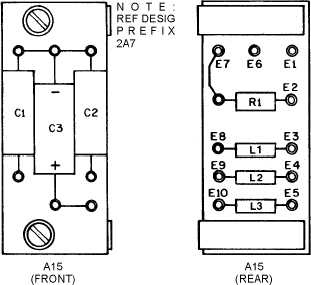1-9
Figure 1-6.—Typical subassembly.
Part
A PART is one component or two or more components joined together. A part is not normally
subject to disassembly without destruction. Resistors, capacitors, and transistors are examples of parts.
Reference Designations.
Reference designations consist of letters, numbers, or both and are used for identification purposes.
Reference designations can be used in several different ways. One important way you will use them is as
a cross-reference for locating supply stock numbers. When you know the reference designator, ordering
the correct replacement for a failed component is easy. You will also use them frequently in corrective
and preventive maintenance. Reference designators will help you to locate test points and adjustments;
they will also help you to move back and forth between various technical manuals, schematics, tables, or
other references.
Each set within a system is assigned an AN nomenclature. Each unit, assembly, subassembly, and
part of a set has an assigned reference designation. Systems, sets, and groups have no reference
designation. The unit is the highest level assigned a reference designator.
Each unit is assigned an identifying number. This number begins with the number 1 and runs
consecutively for all units of a system or a set. Let's look back at the radio transmitting set AN/URT-xx
with the unit numbers 1, 2, 3 on figure 1-4. You should note that these units may also have an AN
nomenclature, such as T-xxx/URT. The T indicates the equipment is a transmitter. The xxx would be
replaced by 3 digits that indicate the model number.
By examining the reference designator of a unit, you will be able to determine in which group, if
any, the unit is contained. Let's look at a complete reference designator for a unit. A good example for us
to break down is the reference designator 2A2A3C1 on figure 1-7.

